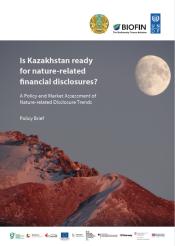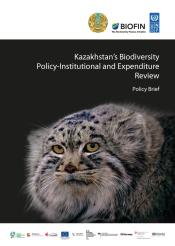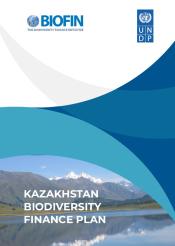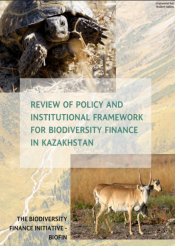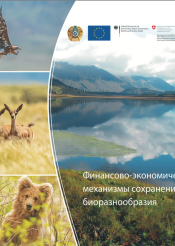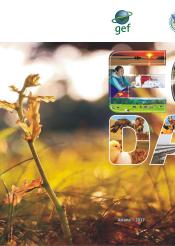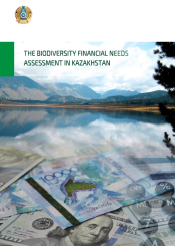Kazakhstan
BIOFIN started in Kazakhstan at the end of 2013. UNDP implements BIOFIN in Kazakhstan jointly with the Forestry and Wildlife Committee under the Ministry of Ecology and Natural Resources. In Kazakhstan, BIOFIN works with the Government, private sector, and civil society to bridge the biodiversity finance gap and align national policies with the Kunming–Montreal Global Biodiversity Framework.
Using the BIOFIN methodology, the Policy and Institutional Review (PIR) and the Biodiversity Expenditure Review (BER) have been conducted regularly as diagnostic tools over an eight-year period since 2008.
Kazakhstan is located deep in Eurasia, with an area of 2.72 million square km. Kazakhstan has a unique variety of landscapes: from deserts to mountains and inland sea ecosystems. Arid and sub-humid lands occupy more than 75 % of the country. They contain more than 40% of the entire species diversity of the country.
Kazakhstan has a huge space of preserved steppe ecosystems that have been destroyed in other countries of Eurasia, enabling a large part of the populations of steppe species to find refuge there. Those include globally threatened species such as saigas, baibak marmots, steppe birch mice, a number of jerboa species, etc., and birds like pallid harriers, lapwings, steppe black-winged pratincoles, white-headed ducks, and many others.
The territory of Kazakhstan is inhabited by vertebrate species that belong to the wild ancestors of domestic animals. Among mammals are mouflon, argali, wild boar, wild ass, wolf, spotted cat and several others. Among birds are primarily mallards, gray geese, quails, and others. Despite the vast territory and low population density, many fauna species are rare or endangered, mainly due to habitat destruction and illegal hunting. The Red Book of Kazakhstan (2006) describes 125 species of vertebrates (15%), including 40 species of mammals and 57 species of birds. The flora of Kazakhstan is estimated to have more than 13 thousand species.
Around 14% of plant species are endemic. Kazakhstan has unique genetic resources of globally important floristic agrobiodiversity (Sivers Apple, Niedzwiecki Apple, and ordinary apricot). According to 2013 data, they include 226 species of wild relatives of cultivated plants, determining the genetic potential for 24 crops.
BIOFIN Kazakhstan’s work on the creation of legislative frameworks for the implementation of six new innovative finance solutions, with the aim of protecting and restoring the country’s nature, is already gaining support at the highest levels in the country.
BIOFIN contributed to the development of the new Environmental Code by proposing norms that aim at the conservation and sustainable use of biological diversity based on the principle of equitable distribution and access to natural benefits. These norms include biodiversity offsets, voluntary payments for ecosystem services, principles for the development of ecotourism in protected areas, carbon offsets, and “green investments”.
These changes in environmental legislation go hand in hand with Kazakhstan’s commitments to conserve biodiversity and achieve carbon neutrality by 2060.
With BIOFIN’s support, all Protected Area (PA) management plans are now officially recognized as budgetary tools, helping to institutionalize results-based financing. Since 2020, state budget allocations for PAs have increased 2.6 times, reaching USD 60 million in 2024.
In 2019, BIOFIN mobilized over USD 798,000 in private investment from the international company Bitfury to pilot a forest carbon offset project, resulting in the identification of 116,800 hectares of unaccounted forests—20,200 of which were added to the State Forest Fund.
BIOFIN supported the development of the country's national ecotourism standard, which went into effect in June 2025 and
To ensure the sustainability of results, modern ecotourism practices and PA financial planning have been introduced into the curricula of three top universities in Kazakhstan, enabling over 2,000 students each year to receive training.
1. Subsidising game breeding to save threatened animal species and develop an improved system of hunting concessions
The aim of the finance solution is to conservation of the natural population of wildlife, through introduced government subsidies for game breeding. The end of result of the finance solution is to preserve wildlife resources and develop the market for sustainable hunting by releasing some animals in the wild while using some animals for hunting, sale and placing on the market (horns, meat, skin, etc.).
2. Creating a basis for certification in the field of ecotourism
Ecotourism development in Kazakhstan would support economic development, increase financing of Protected Areas and expand opportunities for local livelihoods for men and women. The finance solution aims to increase investment in ecotourism infrastructure and services through enhanced government incentives.
3. Strengthening PA management and financial planning for improved state financing
This solution aims to ensure that the 27 protected areas have high-quality budgeted management plans capable of securing adequate government funding for their successful management.
4. Institutionalizing and Enhancing Sustainability of Biodiversity Offsets in Infrastructure Projects Implementation: A Focus on Kazakhstan
The purpose of the financial solution is to introduce a new effective mechanism for the conservation of biodiversity during the industrial projects implementation on the example of the Kansu project. Kazakhstan is an industrial country, industrial development of the territory will continue and the introduction of a financial solution will allow avoiding similar problems in the future.
5. Creating an enabling environment for attracting nature-positive carbon offsets from the international market and multinational enterprises operating in the country
Most of the forests of Kazakhstan (more than 11 million hectares), including rare, endangered, globally important species, remain outside the protected areas. This negatively affects the conservation of forest biodiversity. The forests are in state ownership, financed from the state budget; however, there is a financing gap of more than 35%. The finance solution is aimed at attracting additional attraction of foreign investments for the conservation of forest biodiversity through high-integrity carbon projects. An allocation mechanism will ensure that investors’ financial
resources are directly channeled into forest biodiversity conservation, expanding forest areas, and improving forest management systems.
6. Establishing an internal Forest Carbon Trading System (ETS) and embedding carbon offsets into the national legal framework
Carbon offsets support low-carbon green development and provide a flexible mechanism for reducing carbon in the atmosphere. The relaunched Emissions Trading System (ETS) of Kazakhstan creates an opportunity to include biodiversity-friendly carbon offsets as an official option for the ETS. The solution aims to develop and promote an accepted carbon offset standard in the Forestry sector for Kazakhstan (and regionally) that includes an effective monitoring and evaluation, and verification system. Establishing such a system will offer lower-cost options to offset emissions and increase financing for biodiversity-friendly AFOLU projects.
Policy and Institutional Review is the analyses of the political and socio-economic factors leading to changes in biodiversity and ecosystems. The review includes analysis of a wide range of institutions in general across many industries, defining their roles in planning for biodiversity financing, their impact and interdependence with biodiversity, the coherence between the targets and the national biodiversity goals, and the overall capacity level.
Public and private biodiversity expenditure review for 2008-2014 is completed by the project team in 2015. Under the review the amount and efficiency of allocated funds for biodiversity conservation were determined. According to the analysis, the state budget is the only guaranteed source of biodiversity funding. The total amount of funds for biodiversity in 2008-2014 amounted to 1.2 bln dollars, of them the state budget funds accounted for 87% of total biodiversity funding.
Financial needs assessment for biodiversity conservation in Kazakhstan was completed in 2016. FNA is an assessment of the required expenses to achieve the national goals on biodiversity conservation in Kazakhstan and expected financial gap. According to the assessment, the required budget for the implementation of the national goals is USA 851 million, and the share of the financial deficit from the existing biodiversity financing is more than 55%.
Biodiversity Finance Plan is prepared and under consideration. BFP presents eight mechanisms that were not previously used in Kazakhstan’s practice of biodiversity and ecosystem conservation. BFP includes instruments such as tax incentives, subsidies, offsets.
